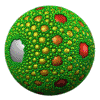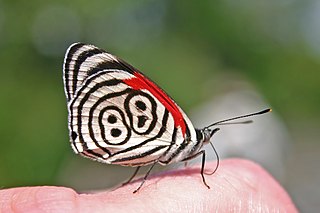Related Research Articles

Transparency is possible in a number of graphics file formats. The term "transparency" is used in various ways by different people, but at its simplest there is "full transparency" i.e. something that is completely invisible. Only part of a graphic should be fully transparent, or there would be nothing to see. More complex is "partial transparency" or "translucency" where the effect is achieved that a graphic is partially transparent in the same way as colored glass. Since ultimately a printed page or computer or television screen can only be one color at a point, partial transparency is always simulated at some level by mixing colors. There are many different ways to mix colors, so in some cases transparency is ambiguous.

Ornithoptera tithonus, the Tithonus birdwing, is a species of birdwing butterfly found on New Guinea and other neighbouring islands.
Nieuwenhuis or Nieuwenhuys is a Dutch surname cognate to English Newhouse and German Neuhaus. A great number of variant forms exist. "Nieuwen" can be replaced by Nei, Neij, Nein, Nie, Nien, Nieuw, Nieuwe, Niewen, Nij, Nijen, Nou and Nuwen. "Huis" can be Hues, Huijs, and Huys. Declensions may end with -se, -sen, -ze, and -zen and the name can start with van ("from"). Notable people with this name include:

Ceryx is a genus of moths in the family Erebidae. It was described by Hans Daniel Johan Wallengren in 1863.

Diaethria is a brush-footed butterfly genus found in the Neotropical realm, ranging from Mexico to Paraguay.

Nudaria mundana, the muslin footman, is a moth of the subfamily Arctiinae. The species was first described by Carl Linnaeus in 1761. It is found in Europe and Anatolia.

Zygaena purpuralis, the transparent burnet, is a moth of the family Zygaenidae.

Troides amphrysus, the Malay birdwing, is a birdwing butterfly in the genus Troides in the family Papilionidae.

Kirk Robert Nieuwenhuis, is an American former professional baseball outfielder who played in Major League Baseball (MLB) for the New York Mets, Los Angeles Angels of Anaheim, and Milwaukee Brewers.
Similodonta is an extinct genus of early bivalve in the extinct family Praenuculidae. The genus is one of eleven genera in the subfamily Praenuculinae. Similodonta is known from Middle Ordovician through Middle Silurian fossils found in Europe and North America. The genus currently contains eight accepted species, Similodonta ceryx, Similodonta collina, Similodonta djupvikensis, Similodonta magna, Similodonta recurva, Similodonta spjeldnaesi, Similodonta wahli and the type species Similodonta similis.
Ceryx basilewskyi is a moth of the family Erebidae. It was described by Sergius G. Kiriakoff in 1955. It is found in Burundi.
Ceryx diptera is a moth of the subfamily Arctiinae. It was described by Johan Christian Fabricius in 1775. It is found in southern India and Sri Lanka. In male, the body is black. Frons, collar and tegulae are yellow. Forewings with a sub-basal, two medial, one sub-apical and two sub-marginal hyaline (glass-like) spots. Hindwings with a sub-basal joined to a sub-marginal spot. Tarsi black. Female is similar to male, but differ with the abdomen dilated and with a tuft of ochreous hairs.
Ceryx helodiaphana is a moth of the subfamily Arctiinae. It was described by Roepke in 1937. It is found on Java.
Ceryx kuehni is a moth of the subfamily Arctiinae. It was described by Walter Rothschild in 1910. It is found on Taam Island, west of Kai Islands in Indonesia.
Ceryx lamottei is a moth of the subfamily Arctiinae. It was described by Sergius G. Kiriakoff in 1963. It was described from Nimba.
Ceryx morobeensis is a moth of the subfamily Arctiinae. It was described by Obraztsov in 1957. It is found in New Guinea.
Ceryx salutator is a moth of the subfamily Arctiinae. It was described by Sergius G. Kiriakoff in 1965. It is found in the Democratic Republic of the Congo.
Ceryx sphenodes is a moth of the subfamily Arctiinae. It was described by Edward Meyrick in 1886. It is found in New Guinea and Queensland, Australia.

The Klebit Bok or Kelavit Bok is the traditional shield of the Kayan and the Kenyah people originating from Borneo.
Cricula ceylonica, the Sri Lankan cricula silkmoth, is a moth of the family Saturniidae. The species was first described by Karl Jordan in 1909 and it is endemic to Sri Lanka. The debate of this species with much broader range circular species - Cricula trifenestrata is not yet fully understood. However, Rougerie et al., in 2009 considered Cricula ceylonica a valid species, probably endemic to Sri Lanka.
References
- ↑ Beccaloni, G.; Scoble, M.; Kitching, I.; Simonsen, T.; Robinson, G.; Pitkin, B.; Hine, A.; Lyal, C., eds. (2003). "Ceryx pseudovigorsi". The Global Lepidoptera Names Index . Natural History Museum . Retrieved April 28, 2018.
- ↑ Nieuwenhuis, E. J. (1946). Tijdschrift voor Entomologie
| This Ceryx-related article is a stub. You can help Wikipedia by expanding it. |